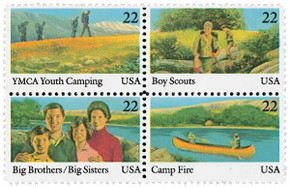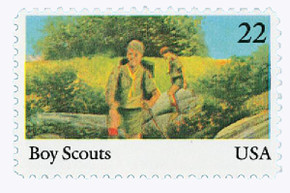
U.S. #2163
1985 22¢ Camp Fire
International Youth Year
- Issued to coincide with the UN’s International Youth Year
- Marks the 75th anniversary of Camp Fire Girls
Stamp Category: Commemorative
Set: International Youth Year
Value: 22¢, first-class rate
First Day of Issue: October 7, 1985
First Day City: Chicago, Illinois
Quantity Issued: 32,500,000
Printed by: American Bank Note Company
Printing Method: Photogravure
Format: Panes of 50 in sheets of 200
Perforations: 11
Why the stamp was issued: To coincide with International Youth Year and to honor the Camp Fire organization.
About the stamp design: All four International Youth Year stamps were designed by Dennis Luzak. The stamps each picture young people in the outdoors with a similar color palette. The Camp Fire organization pictures two campers in a canoe on the water.
First Day City: The First Day ceremony for this set was held at the Chicago International Youth Services Conference in Illinois.
About the International Youth Year Set: Initially, the USPS planned to issue two separate stamps honoring the Big Brothers/Big Sisters program and the 75th anniversary of the Boy Scouts. They eventually decided to add stamps honoring the Camp Fire Girls and YMCA Youth Camping to tie the stamps into the United Nations’ proclamation of 1985 as International Youth Year. 1985 also marked the 100th anniversary of the founding of the first residential summer camp at Lake Orange near Newburgh, New York by the YMCA.
History the stamp represents: In 1979, the General Assembly of the United Nations designated 1985 as the International Youth Year in order to “Draw attention to the situation, needs, and aspirations of youth.” The theme was “Participation, Development, and Peace.” The goals were to stimulate public awareness of the needs of young people and to encourage youth to participate in economic and social development.
At the time of the 1985 International Youth Year, about one fifth of the population was in this age group. The special year emphasized the importance of preparing the youth to be the leaders of tomorrow and the stewards of our planet. In 2010, the U.N. celebrated the 25th anniversary of the International Year of Youth. At the time, the Secretary-General said, “Youth should be given a chance to take an active part in the decision-making of local, national, and global levels.”
Camp Fire
The Camp Fire Girls were formally established on March 17, 1912. Inspired by the Boy Scouts, it was one of the first such programs created for girls in the US.
The Camp Fire Girls owe a large part of their founding to Luther and Charlotte Gulick. In 1907, they opened a camp for girls, Camp WoHeLo, on Lake Sebago in Maine. “Wohelo” was a word Charlotte invented from the first two letters of the words “work,” “health,” and “love.” They operated the camp for a few years and soon started getting requests to create an organization for girls around the country.
So, in March 1911, Dr. Gulick arranged a meeting “to consider ways and means of doing for the girls what the Boy Scout movement is designed to do for the boys.” Then in April the Boy Scouts of America issued a statement that they would soon have a scouting group for girls as well. That year, Gulick’s group, which had been named the Camp Fire Girls, began plans to merge with the Girl Scouts of America and the Girl Pioneers of America. However, they encountered a series of disagreements and the merger didn’t materialize. The Camp Fire Girls of America was then officially incorporated as a national agency on March 17, 1912.
Later that year, Juliette Gordon Lowe proposed merging the Camp Fire Girls with her Girl Guides of America. But the Camp Fire Girls were a larger group by that time, and they declined. By the following December, membership was estimated at 60,000, with many of these girls attended associated summer camps. They also created the Bluebird program that year to offer programs to younger girls. The Camp Fire Girls published their first handbook in 1913.
During World War I, the Camp Fire Girls supported the war effort. They sold over one million dollars in Liberty Bonds and $900,000 in Thrift Stamps. They also provided aid to French and Belgian orphans and earned honors for food conservation. After the war ended, the first local Camp Fire council was established in Kansas City, Missouri, where the national headquarters would later be located.
In 1960, the Camp Fire Girls launched their “She Cares… Do you?” program. During that year they planted over two million trees, built 13,000 bird houses, and performed a number of other conservation related projects.
By 1974, the Camp Fire Girls had 274,000 members in 1,3000 towns across the country. In 1975 they opened the group up to boys as well, re-naming themselves Camp Fire Boys and Girls, or simply Camp Fire. Today Camp Fire services more than one million children and their families through their variety of programs. It continues to teach children outdoor activities and leadership skills.
U.S. #2163
1985 22¢ Camp Fire
International Youth Year
- Issued to coincide with the UN’s International Youth Year
- Marks the 75th anniversary of Camp Fire Girls
Stamp Category: Commemorative
Set: International Youth Year
Value: 22¢, first-class rate
First Day of Issue: October 7, 1985
First Day City: Chicago, Illinois
Quantity Issued: 32,500,000
Printed by: American Bank Note Company
Printing Method: Photogravure
Format: Panes of 50 in sheets of 200
Perforations: 11
Why the stamp was issued: To coincide with International Youth Year and to honor the Camp Fire organization.
About the stamp design: All four International Youth Year stamps were designed by Dennis Luzak. The stamps each picture young people in the outdoors with a similar color palette. The Camp Fire organization pictures two campers in a canoe on the water.
First Day City: The First Day ceremony for this set was held at the Chicago International Youth Services Conference in Illinois.
About the International Youth Year Set: Initially, the USPS planned to issue two separate stamps honoring the Big Brothers/Big Sisters program and the 75th anniversary of the Boy Scouts. They eventually decided to add stamps honoring the Camp Fire Girls and YMCA Youth Camping to tie the stamps into the United Nations’ proclamation of 1985 as International Youth Year. 1985 also marked the 100th anniversary of the founding of the first residential summer camp at Lake Orange near Newburgh, New York by the YMCA.
History the stamp represents: In 1979, the General Assembly of the United Nations designated 1985 as the International Youth Year in order to “Draw attention to the situation, needs, and aspirations of youth.” The theme was “Participation, Development, and Peace.” The goals were to stimulate public awareness of the needs of young people and to encourage youth to participate in economic and social development.
At the time of the 1985 International Youth Year, about one fifth of the population was in this age group. The special year emphasized the importance of preparing the youth to be the leaders of tomorrow and the stewards of our planet. In 2010, the U.N. celebrated the 25th anniversary of the International Year of Youth. At the time, the Secretary-General said, “Youth should be given a chance to take an active part in the decision-making of local, national, and global levels.”
Camp Fire
The Camp Fire Girls were formally established on March 17, 1912. Inspired by the Boy Scouts, it was one of the first such programs created for girls in the US.
The Camp Fire Girls owe a large part of their founding to Luther and Charlotte Gulick. In 1907, they opened a camp for girls, Camp WoHeLo, on Lake Sebago in Maine. “Wohelo” was a word Charlotte invented from the first two letters of the words “work,” “health,” and “love.” They operated the camp for a few years and soon started getting requests to create an organization for girls around the country.
So, in March 1911, Dr. Gulick arranged a meeting “to consider ways and means of doing for the girls what the Boy Scout movement is designed to do for the boys.” Then in April the Boy Scouts of America issued a statement that they would soon have a scouting group for girls as well. That year, Gulick’s group, which had been named the Camp Fire Girls, began plans to merge with the Girl Scouts of America and the Girl Pioneers of America. However, they encountered a series of disagreements and the merger didn’t materialize. The Camp Fire Girls of America was then officially incorporated as a national agency on March 17, 1912.
Later that year, Juliette Gordon Lowe proposed merging the Camp Fire Girls with her Girl Guides of America. But the Camp Fire Girls were a larger group by that time, and they declined. By the following December, membership was estimated at 60,000, with many of these girls attended associated summer camps. They also created the Bluebird program that year to offer programs to younger girls. The Camp Fire Girls published their first handbook in 1913.
During World War I, the Camp Fire Girls supported the war effort. They sold over one million dollars in Liberty Bonds and $900,000 in Thrift Stamps. They also provided aid to French and Belgian orphans and earned honors for food conservation. After the war ended, the first local Camp Fire council was established in Kansas City, Missouri, where the national headquarters would later be located.
In 1960, the Camp Fire Girls launched their “She Cares… Do you?” program. During that year they planted over two million trees, built 13,000 bird houses, and performed a number of other conservation related projects.
By 1974, the Camp Fire Girls had 274,000 members in 1,3000 towns across the country. In 1975 they opened the group up to boys as well, re-naming themselves Camp Fire Boys and Girls, or simply Camp Fire. Today Camp Fire services more than one million children and their families through their variety of programs. It continues to teach children outdoor activities and leadership skills.










